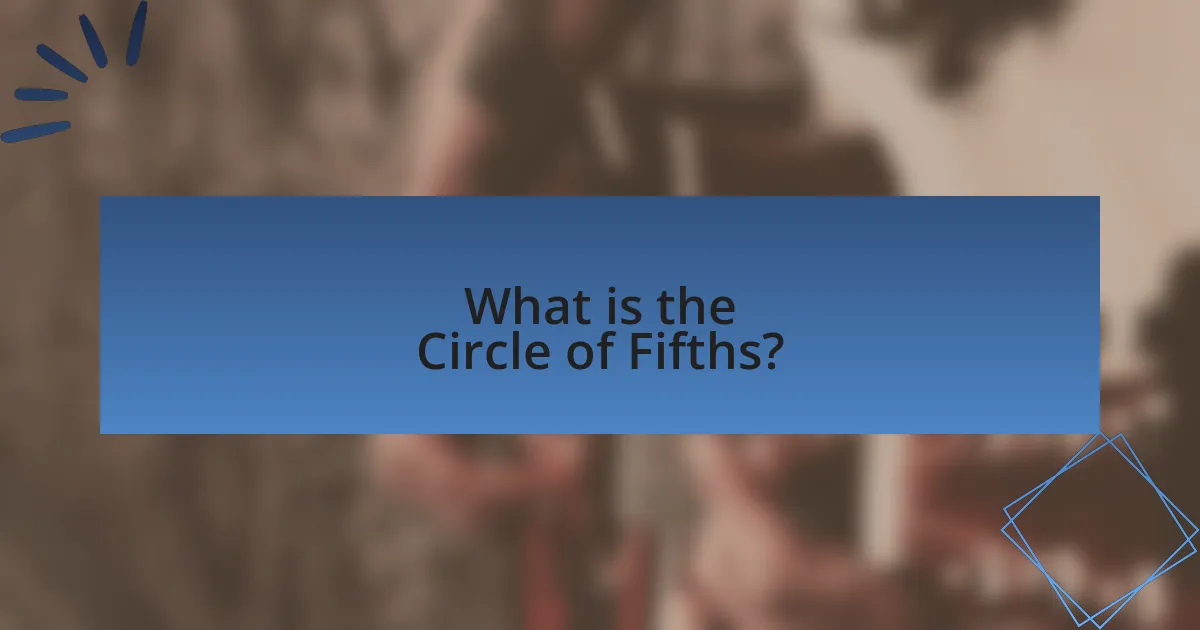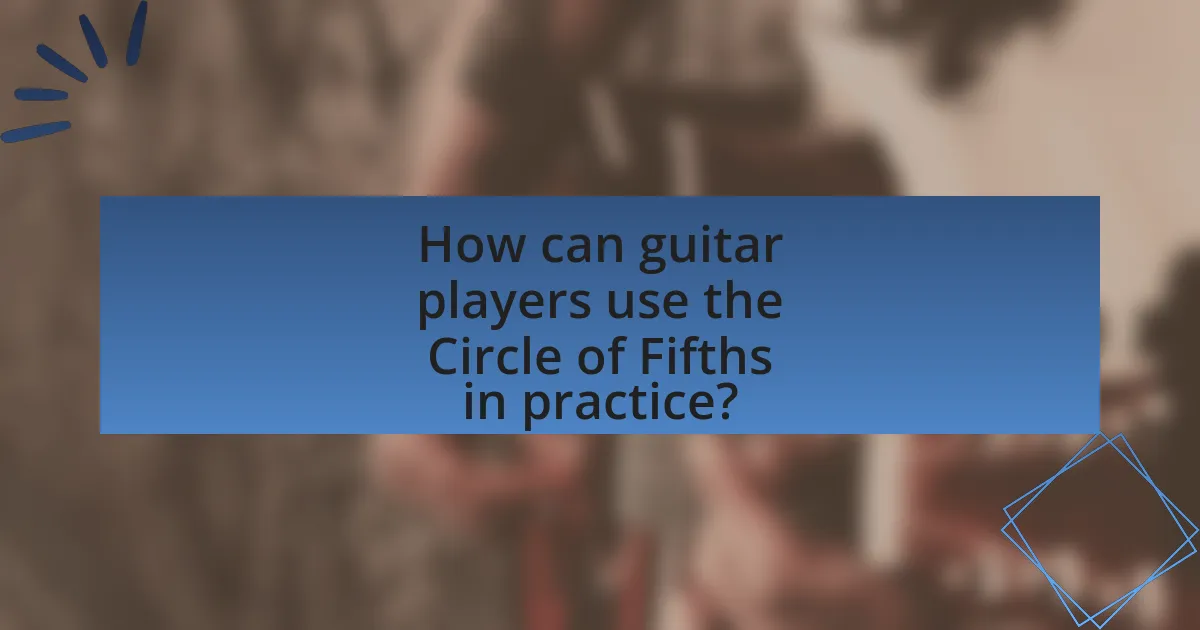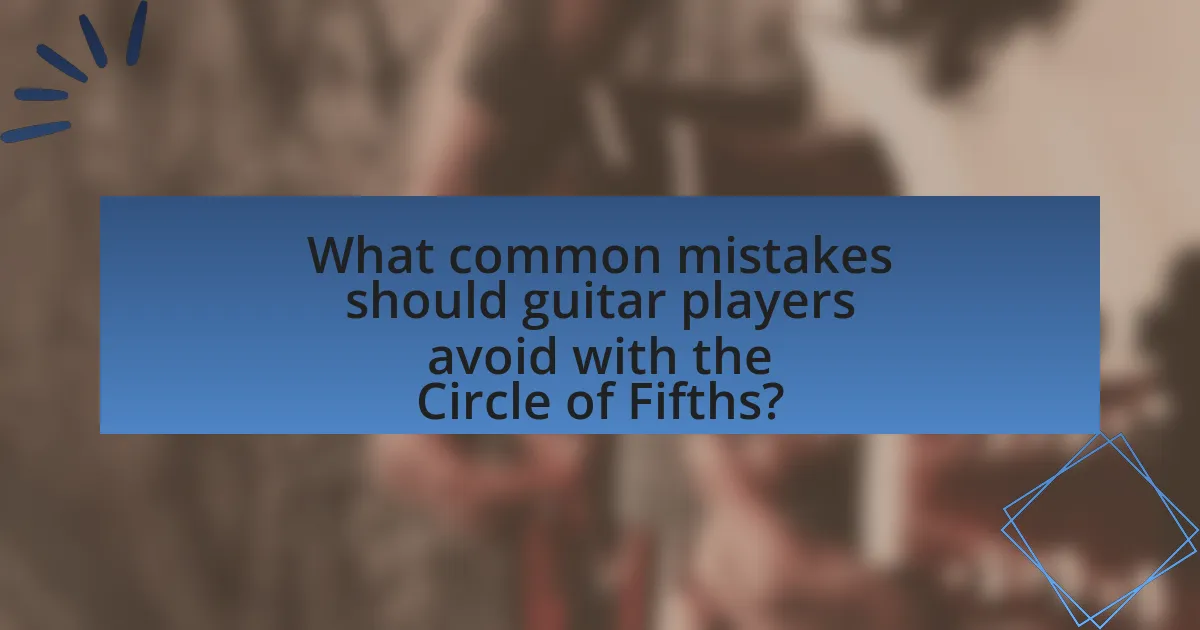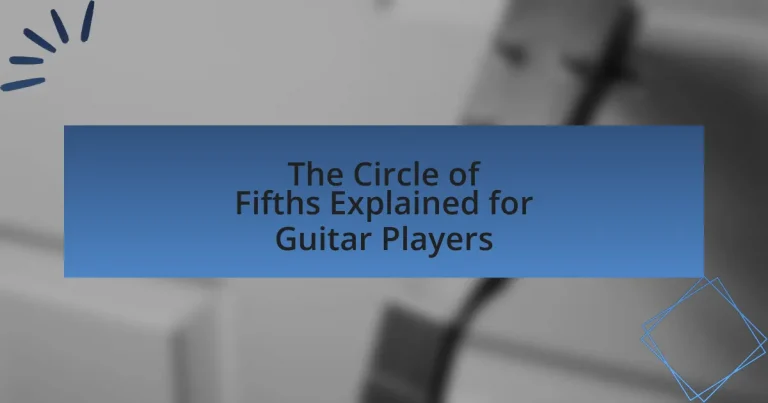The Circle of Fifths is a crucial concept in music theory that visually represents the relationships between the twelve tones of the chromatic scale, their key signatures, and associated major and minor keys. This article provides a comprehensive overview of the Circle of Fifths, detailing its significance for guitar players in understanding key signatures, chord progressions, and improvisation. Key components include the arrangement of tones, the illustration of key signatures, and practical applications for songwriting and practice exercises. Additionally, the article addresses common misconceptions and mistakes related to the Circle of Fifths, offering best practices and resources for further learning.

What is the Circle of Fifths?
The Circle of Fifths is a visual representation of the relationships between the twelve tones of the chromatic scale, their corresponding key signatures, and the associated major and minor keys. It organizes these keys in a circular format, where each key is a perfect fifth apart from its neighbors, facilitating the understanding of key signatures and chord progressions. This concept is foundational in music theory, as it helps musicians, including guitar players, to easily identify and navigate through different keys, enhancing their ability to compose and improvise music effectively.
How does the Circle of Fifths relate to music theory?
The Circle of Fifths is a fundamental tool in music theory that illustrates the relationships between different keys and their corresponding major and minor scales. It organizes the 12 tones of the chromatic scale into a circle, where each step clockwise represents a perfect fifth interval, helping musicians understand key signatures, chord progressions, and modulation. For example, moving clockwise from C major to G major adds one sharp, while moving counterclockwise to F major adds one flat, demonstrating how closely related keys share similar notes. This structure aids guitar players in composing, improvising, and transposing music effectively.
What are the key components of the Circle of Fifths?
The key components of the Circle of Fifths include the arrangement of the twelve tones of the chromatic scale in a circular format, where each tone is a perfect fifth apart. This structure highlights the relationships between major and minor keys, with major keys positioned clockwise and their relative minor keys counterclockwise. Additionally, the Circle of Fifths illustrates the number of sharps or flats in each key signature, providing a visual representation that aids musicians in understanding key relationships and chord progressions.
How does the Circle of Fifths illustrate key signatures?
The Circle of Fifths illustrates key signatures by visually representing the relationship between different keys in music. Each position on the circle corresponds to a specific key signature, with keys arranged in a clockwise manner that increases by perfect fifths, while moving counterclockwise decreases by perfect fourths. For example, starting from C major at the top, moving clockwise leads to G major (one sharp), D major (two sharps), and so on, clearly showing how many sharps or flats each key contains. This arrangement helps musicians quickly identify key signatures and understand their relationships, facilitating easier transposition and composition.
Why is the Circle of Fifths important for guitar players?
The Circle of Fifths is important for guitar players because it provides a visual representation of the relationships between different keys and chords, facilitating easier navigation through music theory. This tool helps guitarists understand key signatures, chord progressions, and modulation, enabling them to compose and improvise more effectively. For instance, by moving clockwise around the circle, players can identify the five sharps in the key of B major, which aids in transposing songs and understanding harmonic relationships.
How can the Circle of Fifths improve chord progression understanding?
The Circle of Fifths enhances chord progression understanding by visually representing the relationships between different keys and chords. This tool allows musicians to easily identify which chords naturally follow one another, facilitating smoother transitions in compositions. For example, moving clockwise on the circle shows the progression of perfect fifths, while moving counterclockwise reveals the progression of perfect fourths. This systematic approach aids in recognizing common chord progressions, such as the I-IV-V progression, which is foundational in many genres. By utilizing the Circle of Fifths, guitar players can develop a deeper comprehension of harmonic structure, leading to more effective songwriting and improvisation.
What role does the Circle of Fifths play in improvisation?
The Circle of Fifths serves as a crucial tool in improvisation by providing a visual representation of key relationships and chord progressions. Musicians utilize the Circle to quickly identify related chords, facilitating smoother transitions and enhancing melodic creativity during improvisation. For example, moving clockwise on the Circle indicates a progression of perfect fifths, which is foundational in many musical genres, allowing improvisers to create harmonically coherent solos. This method is supported by music theory, which emphasizes the importance of key signatures and their relationships, making the Circle an essential reference for effective improvisational practice.

How can guitar players use the Circle of Fifths in practice?
Guitar players can use the Circle of Fifths in practice to understand key signatures and improve their improvisation skills. By visualizing the relationships between different keys, guitarists can quickly identify which chords belong to a particular key, facilitating smoother transitions during playing. For example, moving clockwise around the circle reveals the order of sharps in key signatures, while moving counterclockwise shows the order of flats. This knowledge allows guitarists to compose and improvise more effectively, as they can anticipate chord progressions and modulations. Additionally, practicing scales and arpeggios in relation to the Circle of Fifths enhances a player’s ability to navigate through various musical contexts, reinforcing their overall musicianship.
What are effective exercises for mastering the Circle of Fifths?
Effective exercises for mastering the Circle of Fifths include practicing scales and chords in all keys, using the Circle of Fifths to identify key signatures, and transposing songs through different keys. These exercises help reinforce the relationships between keys and improve overall musical understanding. For instance, playing a C major scale followed by its relative minor, A minor, and then moving through the Circle to G major, D major, and so on, solidifies the concept of key relationships. Additionally, using flashcards to quiz oneself on key signatures and their corresponding major and minor scales can enhance recall and application.
How can guitar players practice scales using the Circle of Fifths?
Guitar players can practice scales using the Circle of Fifths by systematically playing scales in the order of the circle, which helps them understand key signatures and relationships between chords. By starting with the key of C major at the top of the circle and moving clockwise, players can practice the G major scale next, followed by D major, A major, and so on, while also incorporating the relative minor scales. This method reinforces the connection between scales and their corresponding chords, enhancing both technical skills and musical theory comprehension. The Circle of Fifths is a widely recognized tool in music theory, illustrating the relationships between keys, which supports effective scale practice.
What are some chord progression exercises based on the Circle of Fifths?
Chord progression exercises based on the Circle of Fifths include practicing common progressions such as I-IV-V, ii-V-I, and I-vi-ii-V in various keys. These exercises help guitar players understand the relationships between chords and improve their ability to transition smoothly between them. For instance, in the key of C major, the I-IV-V progression consists of the chords C, F, and G, while the ii-V-I progression includes Dm, G, and C. Regularly playing these progressions in different keys reinforces the concept of the Circle of Fifths, which illustrates how each key relates to the others through fifths. This method not only enhances chord recognition but also aids in improvisation and songwriting.
How does the Circle of Fifths aid in songwriting?
The Circle of Fifths aids in songwriting by providing a visual representation of key signatures and their relationships, which helps songwriters create chord progressions and melodies that are harmonically coherent. This tool allows musicians to easily identify closely related keys, facilitating smoother transitions between chords and enhancing the overall musical flow. For example, moving clockwise on the circle reveals keys that share many common chords, making it simpler to compose songs that sound cohesive. Additionally, the Circle of Fifths can inspire creativity by suggesting unexpected key changes or modulations, thus broadening a songwriter’s compositional palette.
What techniques can be used to create melodies with the Circle of Fifths?
Techniques to create melodies with the Circle of Fifths include using chord progressions, exploring key changes, and employing modal interchange. Chord progressions based on the Circle of Fifths, such as moving from C to G to D, provide a strong harmonic foundation for melody creation. Key changes can introduce fresh melodic ideas by shifting to related keys, enhancing the overall musical narrative. Modal interchange allows for the incorporation of notes from parallel modes, enriching the melodic palette. These techniques leverage the relationships between chords and keys outlined in the Circle of Fifths, facilitating the development of cohesive and engaging melodies.
How can the Circle of Fifths help in modulating between keys?
The Circle of Fifths aids in modulating between keys by visually representing the relationships between different key signatures. This tool allows musicians to identify closely related keys, which share many common chords, facilitating smoother transitions. For example, moving from C major to G major involves one sharp and utilizes the shared chords of C, G, and D, making the modulation seamless. The Circle’s layout shows that keys adjacent to each other are more compatible for modulation, thereby providing a practical roadmap for composers and performers to navigate key changes effectively.

What common mistakes should guitar players avoid with the Circle of Fifths?
Guitar players should avoid the mistake of misunderstanding the Circle of Fifths as merely a tool for key signatures. This misconception limits their ability to utilize the Circle for chord progressions and improvisation. Additionally, players often neglect to practice the Circle in different keys, which can hinder their versatility and familiarity with various tonalities. Another common error is failing to recognize the relationships between relative minors and majors, which can lead to missed opportunities in songwriting and arrangement. Lastly, many guitarists overlook the importance of applying the Circle in real musical contexts, such as jamming or composing, which diminishes its practical value in their playing.
What misconceptions exist about the Circle of Fifths?
One misconception about the Circle of Fifths is that it only applies to major keys, while it actually encompasses both major and minor keys. The Circle of Fifths illustrates the relationships between all twelve tones of the chromatic scale, showing how each key relates to its relative minor. Additionally, some believe that the Circle is solely a tool for composition, but it is also essential for understanding chord progressions and improvisation. This broader application is supported by music theory, which emphasizes the importance of the Circle in various musical contexts, including modulation and key changes.
How can misunderstanding the Circle of Fifths affect playing?
Misunderstanding the Circle of Fifths can lead to incorrect chord progressions and key changes in playing. The Circle of Fifths outlines the relationships between different keys and their corresponding chords, which is essential for creating harmonious music. For instance, if a guitarist misinterprets the sequence, they may play chords that clash, resulting in dissonance rather than the intended musical flow. This can hinder improvisation and songwriting, as the musician may struggle to transition smoothly between keys or fail to recognize the appropriate chords for a given scale. Accurate comprehension of the Circle of Fifths is crucial for effective music theory application, ensuring that players can utilize chord relationships to enhance their performance.
What are the pitfalls of neglecting the Circle of Fifths in practice?
Neglecting the Circle of Fifths in practice leads to a lack of understanding of key relationships, which can hinder a guitarist’s ability to improvise and compose effectively. Without this foundational knowledge, musicians may struggle to transition smoothly between keys, resulting in disjointed performances. Additionally, failing to utilize the Circle of Fifths can limit a player’s ability to recognize chord progressions and their functions within a piece, ultimately stifling creativity and musical expression. This is evidenced by the fact that many successful musicians cite their understanding of the Circle of Fifths as crucial for developing their improvisational skills and enhancing their overall musicianship.
What are some best practices for using the Circle of Fifths effectively?
To use the Circle of Fifths effectively, guitar players should practice identifying key signatures and their relative minors, as this enhances understanding of music theory and improves improvisation skills. By memorizing the order of sharps and flats, musicians can quickly determine the key of a piece, facilitating smoother transitions between chords. Additionally, utilizing the Circle to explore chord progressions, such as moving from the tonic to the dominant, can create more dynamic and interesting compositions. Engaging with the Circle in various musical contexts, such as transposing songs or analyzing different genres, further solidifies its practical application in performance and songwriting.
How can guitar players integrate the Circle of Fifths into their daily practice?
Guitar players can integrate the Circle of Fifths into their daily practice by using it to understand key signatures, chord progressions, and improvisation techniques. By familiarizing themselves with the relationships between keys, players can quickly identify which chords belong to a particular key, enhancing their ability to play songs and create music. For example, practicing common chord progressions such as I-IV-V or ii-V-I in various keys helps solidify their understanding of the Circle of Fifths. Additionally, guitarists can use the Circle to explore modulation between keys, allowing for more dynamic and interesting compositions. This method is supported by music theory, which shows that the Circle of Fifths is a foundational tool for understanding harmony and structure in music.
What resources are available for further learning about the Circle of Fifths?
Books, online courses, and interactive websites are available for further learning about the Circle of Fifths. Notable books include “The Complete Musician” by Steven G. Laitz, which provides comprehensive insights into music theory, including the Circle of Fifths. Online platforms like Coursera and Udemy offer courses specifically focused on music theory that cover the Circle of Fifths in detail. Additionally, websites such as musictheory.net provide interactive tools and lessons that help users understand and apply the Circle of Fifths effectively. These resources collectively enhance understanding and practical application of the Circle of Fifths for guitar players.


